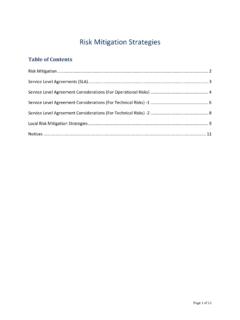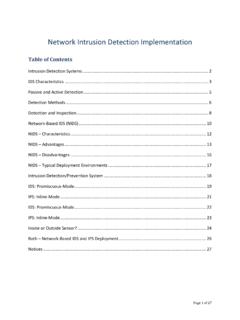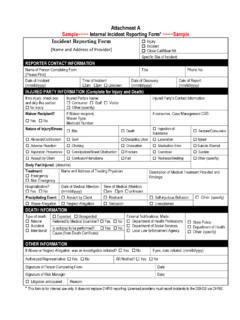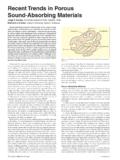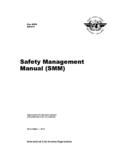Transcription of Sample Incident Cause Analysis Workflow - …
1 Sample Incident Cause Analysis Workflow Table of Contents Cause Analysis Example .. 3 Cyber Incident Cause Analysis .. 4 Initiating Problem, Event, or Threat Vector .. 6 Deliberate Attack .. 7 Initial Foothold .. 9 Vulnerability/Exploit Code -1 .. 10 Vulnerability/Exploit Code -2 .. 11 Impersonation .. 12 Configuration/Feature Abuse .. 13 Denial of Service .. 14 Authentication .. 15 Theft of Equipment .. 16 Other .. 17 User Involvement .. 18 Privilege Escalation on Initial Foothold .. 19 After the Initial Foothold .. 20 Spreading.
2 21 Privilege Escalation .. 23 Initiating Problem, Event, or Threat Vector .. 24 Incident with No Attacker .. 25 Policy Violations .. 26 Page 1 of 34 Data Security Policy Violations .. 27 Example Putting It into Practice .. 28 Example Root Cause Analysis -1 .. 29 Example Root Cause Analysis -2 .. 31 Example Root Cause Analysis -3 .. 33 Notices .. 34 Page 2 of 34 Cause Analysis Example 13[Distribution Statement A] This material has been approved for public release and unlimited Analysis ExampleThe following slides show one possible root Cause Analysis model that categorizes incidents along these attack/threat vectors: deliberate attack- i nitial foothold- after the initial foothold i ncident with no attackerThis model is based on and expanded from the Microsoft Broad Street Taxonomy, which is focused on malware propagation methods.
3 Microsoft Security Intelligence Report Volume 11, Zeroing in on Malware Propagation Methods, **013 And this one's based on a taxonomy that Microsoft developed as part of their Broad Street project, and that particular Broad Street project was designed to identify malware propagation methods and identifying and categorizing how malicious code is propagated. So we took some of those high-level characteristics from the Broad Street taxonomy, which looks at features and characteristics such as user interaction, whether or not there was a vulnerability exploited, and are there any configurable preventative measures that can be put in place, and expanded out to look beyond Page 3 of 34just malware and look at other types of typical attacks and threats.
4 And the higher level is looking at whether or not this was a deliberate attack by a malicious intruder, and distinguishing that from all the other types of innocents where there was no malicious attacker. And then going down the tree of different possibilities, we'll look at other characteristics of each of these higher-level categories and we'll step through these in more detail. Cyber Incident Cause Analysis 14[Distribution Statement A] This material has been approved for public release and unlimited Incident Cause Analysis14 Partial, high-level diagramof some possible threat vectors **014 So here's looking at a higher- level view of looking at a process Page 4 of 34workflow and comparing this-- again, this is adapted from Microsoft's Broad Street taxonomy-- but we're looking, first identifying if there is an attacker, and if there was not, then is there some other reason-- explanation.
5 Some root Cause -- that allowed that particular Incident to occur. Again, We're going to want to go back and look at a different catalog or a list of all different possibilities that could be used to explain any type of Cause for a particular Incident , and then include these in our overlying process taxonomy. Generally for those incidents that there were an attacker, we'll want to identify things as how they initially gained access to the resources that are used. Did they have any user interaction or involvement to allow them access, or they exploit vulnerabilities?
6 Once they got into the system, were they able to escalate their privileges and were they able to spread or propagate that access to other types of systems? So for each of these questions that we're trying to identify yes or no if we can, based on the available data resources, there are follow-up questions that we'll want to address until we can get a complete picture of the underlying causes and what happened in that particular Incident . Page 5 of 34 Initiating Problem, Event, or Threat Vector 15[Distribution Statement A] This material has been approved for public release and unlimited Problem, Event, or Threat VectorWas the Incident due to a deliberate attack?
7 Deliberate attacks deliberately stolen equipment an employee clicking a bad link from an email an employee connecting an already infected laptop to the employer s network insiders deliberately harming the organization an Incident involving malicious codeIncidents with no attacker lost equipment an employee accidentally sending email to the wrong person or list and divulging sensitive information an employee accidentally failing to encrypt PII an employee accidentally taking data home that should not leave the facility other internal problems that were not initiated by a ruse, fraudulent information, or coercion15 **015 So we'll step through each of the different high levels on these coming slides.
8 And so-- this is identifying whether or not it was a deliberate attack versus an Incident that was inadvertent or accidental-- so distinguishing between an attack where someone actually stole a laptop or a piece of equipment versus a use who accidentally lost accidentally lost a piece of equipment or a device. Different patterns and different follow-up approaches and investigations we're going to pursue depending on the answers to these questions. Page 6 of 34An employee might have been tricked and they clicked on a link or they downloaded some malicious code, or maybe the intruder exploited some kind of vulnerability-- a variety of different things distinguishing deliberate attacks from inadvertent or accidental incidents.
9 Deliberate Attack 16[Distribution Statement A] This material has been approved for public release and unlimited AttackIf the Incident included a deliberate attack, try to identify two types of information:1. The initial attack that allowed the attacker to gain a foothold into the organizational infrastructure- Cause of the initial foothold - user involvement during attainment of initial foothold- privilege escalation on initial spreading, propagation, or follow-on incidents after the initial attack(initial foothold gained)
10 - spreading- privilege escalation16 **016 If it was a deliberate attack, some of the things that we're going to want to try to identify is, after the initial attack occurred, what was the underlying Cause to allow them to gain that unauthorized access. Was there any kind of user involved in the initiation of that initial foothold, and were they able Page 7 of 34to escalate their privileges? Maybe they were able to get a user account or information or password and then later on, one they got access to a system, they were able to exploit some other local vulnerability to gain higher levels of privileges after that initial foothold into the system.
